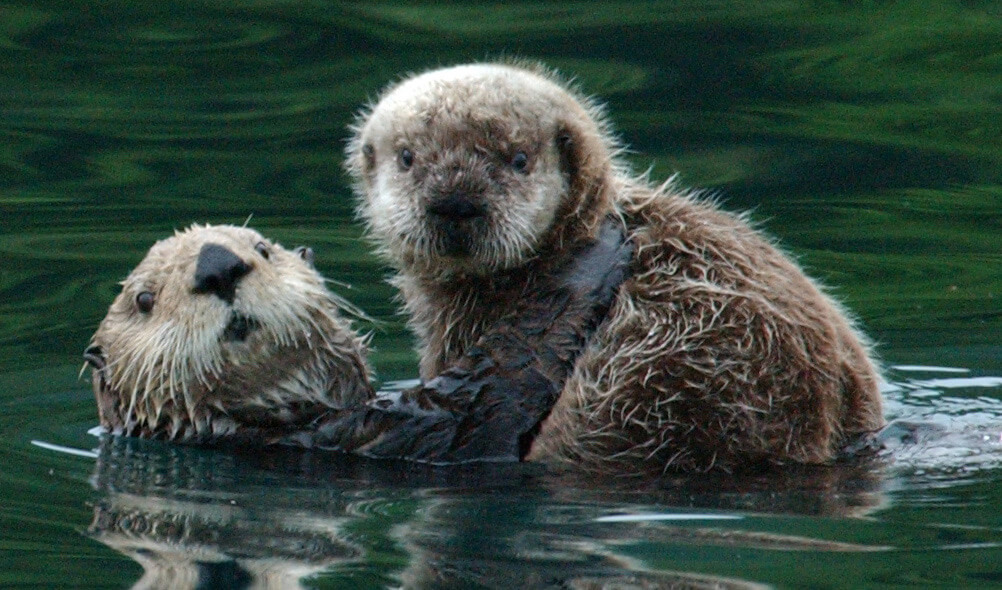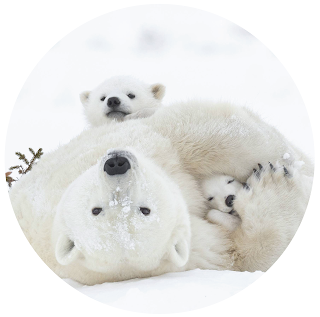Northern Sea Otter of Southwest Alaska by Perry Nalle
Northern Sea Otter of Southwest Alaska
by: Perry Nalle
 |
| https://www.mmc.gov/priority-topics/species-of-concern/northern-sea-otters/ |
Description and Ecology
The Northern Sea Otter of Southeast Alaska is an incredibly fascinating marine mammal. This creature, typically four feet long and between 45 and 65 pounds, has strong teeth, good eyesight, and a large lung capacity. These otters use their whiskers to sense vibrations in the water and are known to use tools to crush their food, particularly when consuming mollusks. Eating more than 45 types of marine species, otters need to eat 25% of their body weight to keep up their high metabolism. Without blubber, this animal stays warm with one of the densest coats of fur in the animal kingdom. Personal grooming also helps to create insulation using air bubbles in their fur. Sea otter reproduction is similar to humans with a year-round mating season. Otters have a gestation period of six to eight months and usually have one pup, but can sometimes have twins.
 |
| https://www.mmc.gov/priority-topics/species-of-concern/northern-sea-otters/ |
In their natural environment, otters do not have many predators other than humans or the occasional killer whale attack. Otters are a keystone species, their existence necessary to the survival of the kelp forests and seagrass communities by preventing overgrazing. By keeping kelp alive, otters indirectly decrease the amount of carbon dioxide in the atmosphere as kelp captures carbon from the ocean. Necessary to these ecosystems, life in these places cannot persist without a strong otter population.
Geographic and Population Changes
| http://www.adfg.alaska.gov/index.cfm?adfg=seaotter.rangemap |
Many years ago, otter populations were spread across the globe, maintaining a significant population in Russia. In the 1700’s, the otter populations were nearly extirpated from this area as well as others due to extensive commercial harvesting. Fur hunters and traders indirectly split this species into two distinct populations United States populations. Now mostly found in Alaska, sea otters have also been known to live in habitats across the Pacific Coast, all the way down to Mexico. A prominent population of the Southern Sea Otter persists in California, but the Northern Sea Otters live primarily in Southern Alaska, the Aleutian Islands, British Columbia and Washington. In the 1960s, more than 400 Northern Sea Otters were translocated around the Alaskan coast to support survival leading to population and range expansion. Scientists and Alaskan residents have recently reported natural population distribution and range shifts over the last decade, especially towards Glacier Bay in Southeast Alaska.
Listing
In February of 2004, the Fish and Wildlife service proposed to list the Northern Sea otter as threatened, which the Endangered Species Act defines as “likely to become endangered in the foreseeable future over all or a significant portion of its range.” By August of 2005, the listing was enacted, and even furthered as Endangered on the IUCN Red List.
Threats
 |
| https://www.pinterest.com/pin/644929609107820206/ |
Once a consistently vibrant population, the Northern Sea Otter has had more than few massive threats to its population over the last few hundred years. After being nearly hunted to extinction for their furs in the 1700s and 1800s, this species regained a healthy capacity through legal protection in 1911. While natural predators can threaten otters at times, humans have a much greater effect on their populations. With similar seafood diets for lobster, crab and sea urchins, otters and humans search for their food in the same places. This causes otters to be caught as fishing bycatch or even directly hunted by their angry human competitors. Otters are also sometimes hunted as game or for their fur, though fur hunting decreased greatly with the North Pacific Fur Seal Convention of 1911.
The otter population also suffers from habitat degradation due to pollution runoff, oil spills and toxic pollutants. As one of the main reasons for listing, oil spills can be huge threat to the Northern Sea Otter. Oil prevents the animal’s fur from being able to insulate, leading to hypothermia and death. In addition, oil is highly toxic to otters affecting their lungs and eyes and causing liver and kidney damage. Another threat to the otter population is the recent and unexplained killer whale attacks. Because of changing climate conditions and a lack of food, this population has been forced to expand out of its natural range into killer whale habitats. This phenomenon of killer whale attacks is even more surprising because before these recent findings, killer whale’s diet has never in history included otters.
The otter population also suffers from habitat degradation due to pollution runoff, oil spills and toxic pollutants. As one of the main reasons for listing, oil spills can be huge threat to the Northern Sea Otter. Oil prevents the animal’s fur from being able to insulate, leading to hypothermia and death. In addition, oil is highly toxic to otters affecting their lungs and eyes and causing liver and kidney damage. Another threat to the otter population is the recent and unexplained killer whale attacks. Because of changing climate conditions and a lack of food, this population has been forced to expand out of its natural range into killer whale habitats. This phenomenon of killer whale attacks is even more surprising because before these recent findings, killer whale’s diet has never in history included otters.
Recovery Plan
The Recovery Plan for the Northern Sea Otter is designated specifically for the distinct Alaskan population. Aerial survey information shows a greater than 50% decline of this population since the 1980’s. The current population spreads over multiple metapopulations in habitats that vary in size and vastness. To most efficiently protect this species, the recovery plan split up the species into five designated units. The units include the Western and Eastern Aleutian Islands, South Alaska Peninsula, Bristol Bay and Kodiak, Kamishak, Alaska Peninsula.
 |
| http://dangerous-wild-animals.blogspot.com/2011/03/sea-otter.html |
The goals of the recovery plan is to protect this species and control and reduce threats to survival. A recovery team of 15 members was established in 2006 to create and implement the Northern Sea Otter Recovery Plan. The point of the recovery plan, if completed, is to reclassify the species to a less critical status. The main objective is to mitigate threats in order to maintain a self-sustaining population that can play a functional role to the nearshore ecosystem. In order to achieve this, the Recovery plan outlines goals to monitor the kelp forest ecosystem and all parts of the sea otter’s habitat. The team also wants to maintain preventative measures and ensure adequate response to oil spills. The approximate cost of implementing this plan of the next five years is $15 million.
(7) Fish and Wildlife Service- https://www.fws.gov/alaska/fisheries/mmm/stock/finalsoutheastalaskaseaottersar01aug2008.pdf
What Can You Do?
Visit defenders.org/sea-otter to help. On this website, you can symbolically adopt a sea otter, contact government leaders, become an advocate and stay informed with the most updated information about the population and its survival. You can also become a “Defender of Wildlife” to fundraise for the protection of the Northern Sea Otter. You can fundraise or donate to help aid survival at wildanimalhealthfund.org. Learn more about how being environmentally aware can help sea otters at awesomeocean.com.
Other Resources
- Find out more information at the Monterey Bay Aquarium https://www.montereybayaquarium.org/animals-and-experiences/exhibits/sea-otters
- Find more ways to help. http://awesomeocean.com/top-stories/12-ways-can-help-sea-otters/
- Learn more at http://www.defenders.org/.
Works Cited:
(1) Southwest Alaska Distinct Population Segment of the Northern Sea Otter Recovery Plan - https://ecos.fws.gov/docs/recovery_plan/Recovery%20Plan%20SW%20AK%20DPS%20Sea%20Otter%20Aug13.pdf (2) US Fish and Wildlife Service- ecos.fws.gov/ecp0/profile/speciesProfile?spcode=A0HK(3) International Union for Conservation of Nature and Natural Resources- www.iucnredlist.org/details/7750/0(4) Defender of Wildlife- www.defenders.org/sea-otter/threats(5) Earthwatch Institute- earthwatch.org/Expeditions/Sea-Otters-and-Seagrass-in-Alaska(6) Wild Animal Health Fund- https://www.wildanimalhealthfund.org/sea-otters.html(7) Fish and Wildlife Service- https://www.fws.gov/alaska/fisheries/mmm/stock/finalsoutheastalaskaseaottersar01aug2008.pdf




In you threats section I thought you did a really good job of explaining the threats instead of just listing them. For instance, we all know oil spills are bad but not necessarily why they are bad so explaining that it affects their fur to the extent they cant insulate themselves and that it is toxic to their lunch and eye was super informative.
ReplyDelete~Sage Massey
I really liked the layout of your blog. It is well organized and provides a plentiful amount of information. You gave the reader a good amount of background information about this organism throughout your blog and helped them easily understand it.
ReplyDelete-Mckenna Moura
I loved the organization of this blog and thought you were really well informed about this species. You did a great job of explaining all the main points to your audience and did it in a clear and informative manner. I also loved all your photos, it totally caught my attention.
ReplyDelete-Parker Ornellas
The layout was very well done and you did a very good job when describing threats! I really enjoyed learning more about Sea Otters!
ReplyDelete-Christine Okimura
Great blog! I did the Southern Sea Otter so it was interesting seeing the similarities and differences between the two different populations.
ReplyDelete-Fiona McCallion
Your description of the Sea Otter was very clear and informative. You included a lot of detailed information about the population changes, which was interesting to read.
ReplyDelete-Kristen Nagamatsu
The threats are well explained and show great ways to help the Otter. I enjoyed the images you chose.
ReplyDelete-Ali Murray
Your blog was very clear and informative and very interesting to read
ReplyDelete-Bryn Mulligan